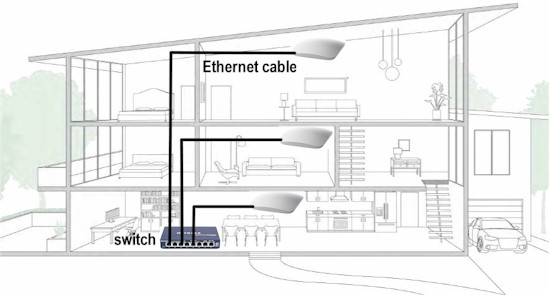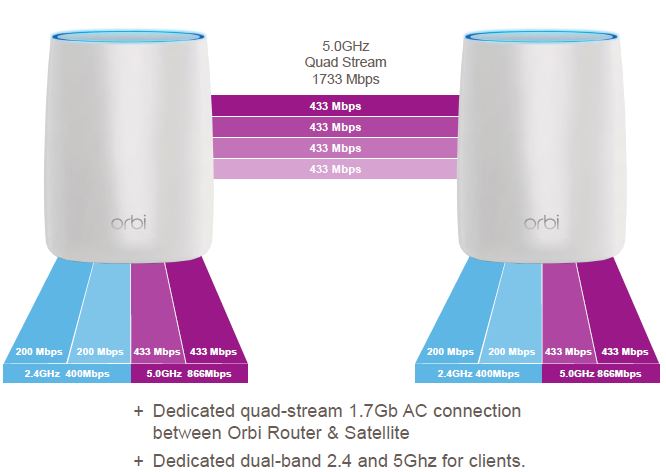This article is sponsored by NETGEAR.

Covering this home with fast Wi-Fi can be a challenge
If your home has a Wi-Fi network (and whose doesn’t), you know what used to work isn’t cutting it any more. Gone are the days when web browsing, email and maybe chat were what was meant by "using the internet".
Today, your network likely has a dozen or more Wi-Fi devices. More of them, like security cameras, are using bandwidth constantly. You’re also likely getting more internet bandwidth battles where gamers compete for lowest lag, cord-cutters want glitch free HD video and no one wants to huddle near the router to get it. Internet connection speeds have also increased to over 100 Mbps and up to a Gigabit in some areas and it’s only natural that Wi-Fi users want to access every last bit of it no matter where they roam in the home.
The past year has seen the emergence of products using a new approach to solving Wi-Fi coverage. We define coverage as the ability to do what you want to do (stream video, game, browse the web), where you want to do it (basement, living room, etc.). This is vastly different from the typical claim of X,000 sq. ft. "coverage" where you might get a barely detectable signal, not where you’ll get one you can actually use.
These new products go by many names, i.e. Wi-Fi "system", "surround" Wi-Fi", "mesh" Wi-Fi, but have one thing in common; the use of multiple devices to form a distributed Wi-Fi architecture. The devices are acutally Wi-Fi access points (AP) that can be spread throughout your home, minimizing the distance between AP and device for stronger signals.
The multi-AP approach has been used for years in large business-class Wi-Fi systems with great success. But the key difference between multi-AP business Wi-Fi and these new consumer systems, which we’ll call "mesh" Wi-Fi, is how the APs are connected.
Watch Your Backhaul
These connections, also known as "backhaul", ultimately determine the bandwidth each AP can deliver. If an AP’s backhaul is, say, 10 Mbps, then an uncompressed Blu-ray movie that requires 20 Mbps will never smoothly stream through it, no matter how big its number (AC1200, AC5300, etc.) is.
Business Wi-Fi systems use Ethernet to link APs, providing reliable, stable and high-bandwidth wired network connection. Ethernet backhaul connections in most of today’s networks are Gigabit or 1,000 Mbps. Even with protocol overhead, Gigabit Ethernet connections can provide around 940 Mbps of actual, usable throughput. And with the use of Ethernet switches and separate cables, each AP gets a full Gigabit connection.

APs with Ethernet backhaul
In mesh systems, typically only one AP (node) is connected to the Ethernet network (the root node) and other nodes link to it via Wi-Fi. If a node can’t connect directly to the root node, it must connect via another node, creating a "hop" or retransmission. Each hop can reduce bandwidth available to the next node up to 50%, illustrated in the graphic below by increasingly narrower arrows.

APs with Wi-Fi mesh backhaul
Mesh product designers try to work around this problem by receiving on one band and retransmitting on the other band when nodes have two radios. But as the number of nodes increase, managing the backhaul connections gets more complicated, eating up bandwidth due to management overhead.
The problem gets even more complicated when client device bandwidth demands are added. Since bandwidth must be shared between servicing backhaul and clients, one or the other suffers when bandwidth demand is high. Managing competing bandwidth demands is so complex, mesh providers use a cloud service to handle the computation load. This makes the system even more complex and compete for internet connection bandwidth as well as Wi-Fi bandwidth.

APs with Wi-Fi mesh backhaul
A Different Approach
NETGEAR’s new Orbi takes a more staightforward approach. While most mesh Wi-Fi systems push three-packs of mesh nodes, Orbi needs only two elements. The Router connects to your ISP’s modem or router and shares the internet connection, while the Satellite acts as an extension AP. A quad-stream 4×4 5 GHz radio provides dedicated high-bandwidth backhaul between the Orbi Router and Satellite. Each also has a 2×2 AC1200 class simultaneous dual-band radio dedicated to serving client devices for a total of three radios per unit.

NETGEAR Orbi Wi-Fi Architecture
This means there is no bandwidth battle between backhaul and client; each gets what it needs. The dedicated 5 GHz backhaul acts like wireless Gigabit Ethernet cable, providing higher bandwidth to the Satellite unit, which is then passed on to client devices. The tri-radio architecture also means there is no bandwidth-sapping "hop" introduced by the Satellite because there a different radio used for backhaul and clients.

NETGEAR Orbi Wi-Fi advantage
The Orbi Router and Satellite come already linked, so setup is quick and easy. A lighted "halo" changes color to indicate whether the backhaul connection is good, bad or in between.

NETGEAR Orbi backhaul
Anyone who has used a wireless extender has probably wrestled with devices that keep choosing slow connections. Orbi addresses this by "Smart Connect:" band steering for dual-band capable devices, which measures signal level on both bands and connects the device to the best one. Orbi also supports 802.11k and v so that devices that also support these new standards for fast roaming will smoothly and quickly move between Router and Satellite.

The result is that Orbi sets a new standard for providing fast, secure and reliable whole-home Wi-Fi, providing Wi-Fi you can rely on. Everywhere. Get Orbi today and experience Wi-Fi the way it was meant to be.

 Read more about NETGEAR.
Read more about NETGEAR.